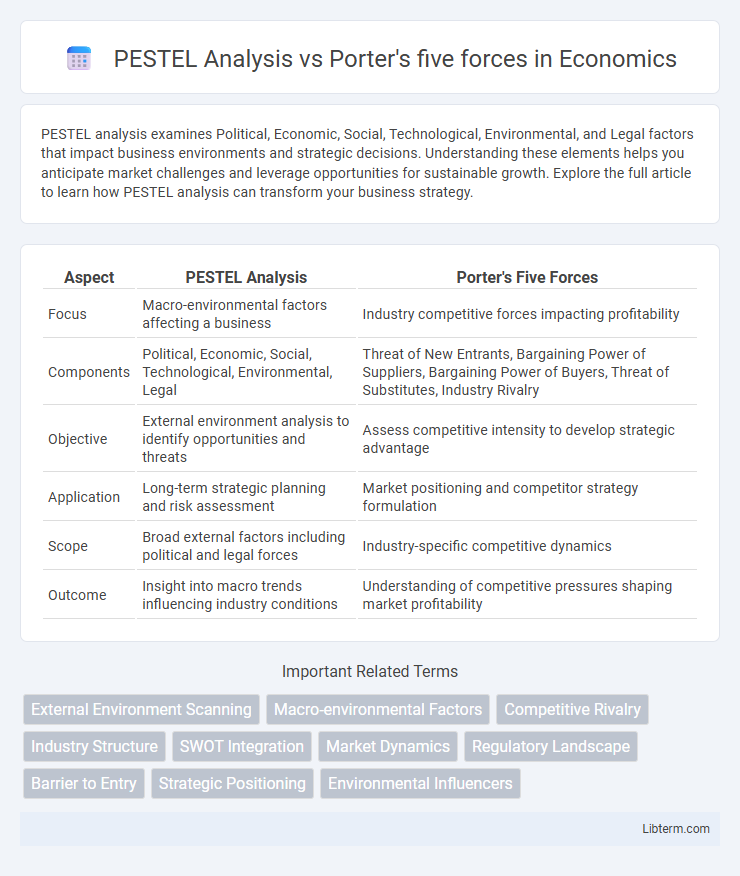PESTEL analysis examines Political, Economic, Social, Technological, Environmental, and Legal factors that impact business environments and strategic decisions. Understanding these elements helps you anticipate market challenges and leverage opportunities for sustainable growth. Explore the full article to learn how PESTEL analysis can transform your business strategy.
Table of Comparison
| Aspect | PESTEL Analysis | Porter's Five Forces |
|---|---|---|
| Focus | Macro-environmental factors affecting a business | Industry competitive forces impacting profitability |
| Components | Political, Economic, Social, Technological, Environmental, Legal | Threat of New Entrants, Bargaining Power of Suppliers, Bargaining Power of Buyers, Threat of Substitutes, Industry Rivalry |
| Objective | External environment analysis to identify opportunities and threats | Assess competitive intensity to develop strategic advantage |
| Application | Long-term strategic planning and risk assessment | Market positioning and competitor strategy formulation |
| Scope | Broad external factors including political and legal forces | Industry-specific competitive dynamics |
| Outcome | Insight into macro trends influencing industry conditions | Understanding of competitive pressures shaping market profitability |
Introduction to Strategic Analysis Tools
PESTEL analysis examines macro-environmental factors--Political, Economic, Social, Technological, Environmental, and Legal--that impact an organization's strategic decisions, enabling comprehensive assessment of external influences. Porter's Five Forces framework analyzes industry competitiveness by evaluating the bargaining power of suppliers and buyers, threat of new entrants, threat of substitutes, and competitive rivalry, providing insights into market profitability and competitive advantage. Both tools are fundamental in strategic analysis, with PESTEL offering a broad external overview and Porter's model delivering industry-specific competitive dynamics for informed strategic planning.
Overview of PESTEL Analysis
PESTEL Analysis evaluates external macro-environmental factors influencing an organization, including Political, Economic, Social, Technological, Environmental, and Legal dimensions. This framework helps businesses identify potential opportunities and threats arising from the broader external environment. Unlike Porter's Five Forces, which assesses industry-specific competitive dynamics, PESTEL provides a holistic view of external influences shaping strategic decision-making.
Overview of Porter’s Five Forces
Porter's Five Forces framework analyzes industry competitiveness through five key forces: threat of new entrants, bargaining power of suppliers, bargaining power of buyers, threat of substitute products or services, and industry rivalry. This model helps businesses understand the dynamics affecting profitability and strategic positioning within a specific market. Unlike PESTEL analysis, which examines broader macro-environmental factors, Porter's Five Forces focuses on competitive pressures directly shaping industry structure.
Key Components of PESTEL Analysis
PESTEL Analysis focuses on six key components: Political, Economic, Social, Technological, Environmental, and Legal factors that influence a business's external environment. These components help identify macro-environmental trends impacting industry dynamics and long-term strategic planning. In contrast, Porter's Five Forces analyze industry competitiveness through competitive rivalry, threat of new entrants, bargaining power of suppliers and buyers, and threat of substitutes.
Key Components of Porter’s Five Forces
Porter's Five Forces framework includes the key components of competitive rivalry, the threat of new entrants, the bargaining power of suppliers, the bargaining power of buyers, and the threat of substitute products or services. These forces collectively assess industry competition and profitability potential by analyzing market dynamics and external pressures on a business. Unlike PESTEL analysis, which examines broader macro-environmental factors like political, economic, social, technological, environmental, and legal influences, Porter's model specifically focuses on the micro-environmental forces shaping competition within an industry.
Comparative Application in Business Strategy
PESTEL analysis evaluates external macro-environmental factors--Political, Economic, Social, Technological, Environmental, and Legal--that impact strategic decision-making, providing a broad context for market opportunities and threats. Porter's Five Forces focuses on micro-environmental industry dynamics, analyzing competitive rivalry, the threat of new entrants, supplier and buyer power, and the threat of substitutes to shape competitive positioning. In business strategy, PESTEL guides long-term environmental adaptation while Porter's Five Forces drives competitive advantage through industry structure assessment.
Strengths and Limitations of PESTEL
PESTEL analysis excels in identifying macro-environmental factors impacting a business, such as political, economic, social, technological, environmental, and legal influences, providing a broad strategic overview. Its limitation lies in its broad scope, which may overlook industry-specific competitive dynamics that Porter's Five Forces effectively analyze, including supplier power, buyer power, competitive rivalry, threat of substitution, and threat of new entrants. PESTEL is ideal for understanding external forces shaping market conditions, while it lacks the depth in assessing internal industry competitiveness offered by Porter's framework.
Strengths and Limitations of Porter’s Five Forces
Porter's Five Forces framework excels in analyzing industry competition by examining supplier power, buyer power, competitive rivalry, threat of substitution, and threat of new entrants, providing strategic insights into market dynamics. Its primary strength lies in focusing on the micro-environmental factors that directly influence profitability and competitive intensity within an industry. Limitations include its less effective application to rapidly changing markets and inability to address macro-environmental factors such as political, economic, social, technological, environmental, and legal influences, which are better captured by PESTEL analysis.
When to Use PESTEL vs Porter’s Five Forces
PESTEL analysis is ideal for understanding macro-environmental factors such as political, economic, social, technological, environmental, and legal influences affecting an entire industry or market. Porter's Five Forces focuses on competitive dynamics within an industry, analyzing threats from new entrants, bargaining power of suppliers and buyers, threat of substitutes, and competitive rivalry. Use PESTEL for strategic planning and market entry decisions, while Porter's Five Forces is best for assessing industry profitability and competitive positioning.
Conclusion: Integrating Both Frameworks
Integrating PESTEL analysis with Porter's Five Forces provides a comprehensive strategic framework by combining external macro-environmental factors with industry-specific competitive forces. Leveraging insights from PESTEL helps identify political, economic, social, technological, environmental, and legal trends that shape market conditions, while Porter's model assesses rivalry, threat of new entrants, supplier power, buyer power, and substitute threats within the industry. Together, these frameworks enable businesses to develop robust strategies that address both broad environmental influences and detailed competitive dynamics.
PESTEL Analysis Infographic

 libterm.com
libterm.com